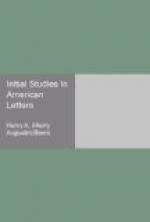The four writers last mentioned, have all come to the front within the past eight or ten years, and, in accordance with the plan of this sketch, receive here a mere passing notice. It remains to close our review of the literary history of the period since the war with a somewhat more extended account of the two favorite novelists whose work has done more than any thing else to shape the movement of recent fiction. These are Henry James, Jr., and William Dean Howells. Their writings, though dissimilar in some respects, are alike in this, that they are analytic in method and realistic in spirit. Cooper was a romancer pure and simple; he wrote the romance of adventure and of external incident. Hawthorne went much deeper, and with a finer spiritual insight dealt with the real passions of the heart; and with men’s inner experiences. This he did with truth and power; but, although himself a keen observer of whatever passed before his eyes, he was not careful to secure a photographic fidelity to the surface facts of speech, dress, manners, etc. Thus the talk of his characters is book-talk, and not the actual language of the parlor or the street, with its slang, its colloquial ease and the intonations and shadings of phrase and pronunciation which mark different sections of the country and different grades of society. His attempts at dialect, for example, were of the slenderest kind. His art is ideal, and his romances certainly do not rank as novels of real life. But with the growth of a richer and more complicated society in America fiction has grown more social and more minute in its observation. It would not be fair to classify the novels of James and Howells as the fiction of manners merely; they are also the fiction of character, but they aim to describe people not only as they are, in their inmost natures, but also as they look and talk and dress. They try to express character through manners, which is the way in which it is most often expressed in the daily existence of a conventional society. It is a principle of realism not to select exceptional persons or occurrences, but to take average men and women and their average experiences. The realists protest that the moving incident is not their trade, and that the stories have all been told. They want no plot and no hero. They will tell no rounded tale with a denouement, in which all the parts are distributed, as in the fifth act of an old-fashioned comedy; but they will take a transcript from life and end when they get through, without informing the reader what becomes of the characters. And they will try to interest this reader in “poor real life” with its “foolish face.” Their acknowledged masters are Balzac, George Eliot, Turgenieff, and Anthony Trollope, and they regard novels as studies in sociology, honest reports of the writers’ impressions, which may not be without a certain scientific value even.




